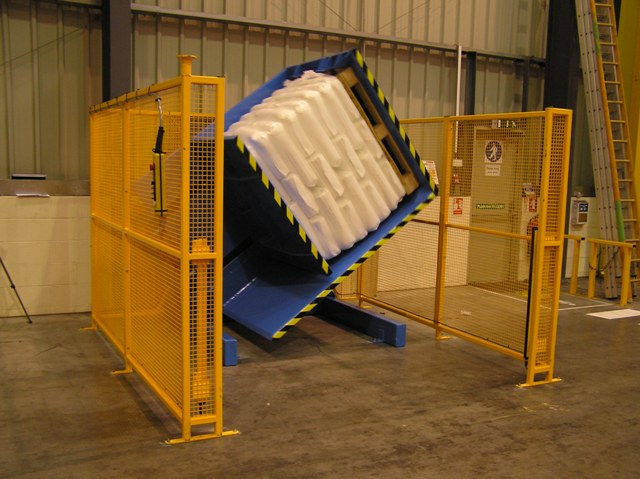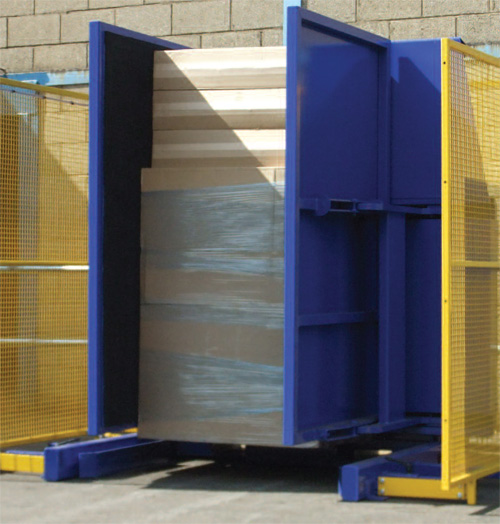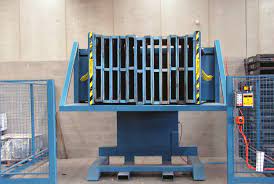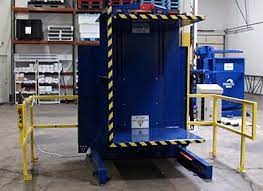Pallet Changing Machine: What’s the Quickest Way to Swap Anti-Static Pallets?
As an engineer who has spent his life in the packaging industry, I've seen a lot of factories. I've walked the floors of sprawling steel mills and watched as small inefficiencies create huge bottlenecks. One of the most common, yet often overlooked, problems is dealing with pallets. You have a heavy, valuable load on a broken wooden pallet, or you need to switch it to a specific anti-static pallet for a cleanroom or a special shipment. Your entire multi-million dollar production line grinds to a halt while workers struggle to manually restack the load. This process is slow, it’s dangerous, and it costs you money every second the line isn't moving. It’s a persistent headache that chips away at your plant's overall efficiency and your bottom line. But what if you could solve this problem in under 60 seconds, safely and automatically? A dedicated pallet changing machine is the solution that turns this critical bottleneck into a smooth, efficient part of your workflow.
The quickest and most efficient way to swap anti-static pallets is by using an automated pallet changing machine, often called a pallet inverter or pallet exchanger. This equipment securely clamps the entire load, then either rotates it 180 degrees or uses a pushing mechanism to slide the load from the old pallet to the new anti-static one. The entire process typically takes less than a minute, drastically reducing manual labor, eliminating product damage, and getting your production line moving again almost instantly.

I know from experience that in a high-stakes environment like a steel mill, every piece of equipment must justify its existence with a clear return on investment. You're not just buying a machine; you're investing in uptime, safety, and efficiency. So, let’s move beyond the simple answer and dig into the practical questions. How does this machine actually boost your uptime? What are the real costs involved? And how does it fit into a modern, digitally-transformed factory? Let’s explore how this single solution can address some of the biggest challenges you face every day.
How Can a Pallet Changer Boost Your Operational Uptime?
You're aiming for 95% operational uptime, but your equipment is over 15 years old. An unexpected failure can cascade through your entire process. A simple broken pallet in the dispatch area seems minor, but it can stop a production line worth millions. This small problem creates a major blockage. Your team has to stop what they're doing, find a forklift, and manually handle a heavy, unstable load. This manual intervention is the enemy of uptime. A pallet changing machine directly targets this inefficiency. It provides a standardized, rapid solution to a recurring problem, ensuring that a minor pallet issue doesn't derail your entire schedule.
A pallet changer boosts uptime by replacing a slow, unpredictable manual process with a fast, automated one. By doing this, it directly reduces line stoppages caused by damaged pallets or the need to switch pallet types for specific customers or shipping standards. This simple change can have a massive impact on achieving your goal of 95% effective run time, turning a common bottleneck into a streamlined process.

The True Cost of Downtime from a Single Pallet
When a pallet fails, the direct cost of the pallet itself is insignificant. The real cost is in the stopped time. Let’s break it down. For a high-capacity steel mill, every minute of lost production represents a significant financial loss. When a line stops, you are still paying for energy, labor, and overheads, but with zero output. I remember a client in the steel wire industry who faced this exact issue. Their final packing stage was their biggest source of unplanned downtime. A broken pallet meant stopping the wrapping machine, calling for a forklift, and having three workers spend 20-30 minutes manually restacking coils of steel wire. This happened multiple times a week. After we installed a simple pallet inverter, the entire swap process took one worker less than two minutes. Their downtime in that section dropped by over 80%.
From Reactive Fix to Proactive Flow
A pallet changer does more than just fix broken pallets. It gives you operational flexibility. For instance, you might produce and store products on cheaper, in-house wooden pallets but need to ship them on higher-quality plastic or anti-static pallets to meet customer requirements or export standards. Without a pallet changer, this becomes a major manual task. With one, it's a simple, integrated step in your logistics flow. This proactive approach prevents bottlenecks before they happen. It allows you to standardize your internal processes while still having the agility to meet diverse external demands, keeping your lines running smoothly and consistently. This is a crucial step in moving from a reactive maintenance culture to a proactive, efficiency-focused operational model.
Calculating the Uptime Advantage
Let's look at the numbers. Consider the difference between a manual and an automated swap.
| Metric | Manual Pallet Swap | Automated Pallet Changer | Impact |
|---|---|---|---|
| Time per Swap | 20-30 minutes | < 2 minutes | >90% time reduction |
| Labor Required | 2-3 workers + forklift operator | 1 worker | >75% labor reduction |
| Risk of Damage | High (manual handling) | Very Low (secured load) | Protects valuable product |
| Safety Risk | High (lifting, instability) | Very Low (guarded process) | Protects your people |
As you can see, the argument for uptime is compelling. The machine pays for itself not just in labor savings, but in the recovered production time that was previously lost to these minor, but frequent, interruptions.
What Are the Key Cost Factors When Choosing a Pallet Changing Machine?
You are a practical business owner. You know that every investment must be scrutinized for its return. When looking at a pallet changing machine, the sticker price is only one part of the equation. You could overspend on a complex, fully-automated system with features you'll never use. Or, you could underspend on a light-duty machine that won't withstand the rigors of a steel plant environment, leading to breakdowns and negating any initial savings. The key is to find the right balance for your specific needs. As someone who has built these machines, I can tell you that understanding the core cost drivers is the first step to making a smart investment.
The key cost factors for a pallet changing machine are its automation level, load capacity, clamping system, and construction materials. A fully automated, high-capacity, stainless steel machine will be at the top end of the price range. A simpler, semi-automatic model with a standard painted finish for lower-weight loads will be much more affordable. A careful analysis of your typical load weight, required cycle time, and operating environment is essential to select a machine that provides the best long-term value and return on investment.

Deconstructing the Costs: What Are You Paying For?
The final price of a pallet changer is a sum of its parts and engineering complexity. It's important to know what you need, and what you don't.
-
Automation Level: This is the biggest cost driver.
- Manual/Semi-Automatic: An operator uses levers or buttons to control the clamping and rotation. These are robust, cost-effective, and great for operations with lower throughput.
- Fully Automatic: The machine is integrated into a conveyor line. Pallets are fed in and out automatically. This is for high-volume operations where minimizing cycle time is paramount. The cost is higher due to PLCs, sensors, and integration engineering.
-
Load Capacity: A machine rated for 1,000 kg will be fundamentally different from one built for 2,500 kg. Higher capacities require a stronger frame, a more powerful hydraulic or electric system, and more robust components. For a steel mill, you must be realistic about your heaviest loads and choose a machine with a capacity that exceeds your maximum requirement for a good safety margin.
-
Clamping Mechanism: The method used to hold your product determines the machine's versatility.
- Side Clamps: Ideal for stable, boxed, or rigid loads.
- Top Press: Essential for securing uneven or unstable loads, like bags or pails. This adds complexity and cost but is non-negotiable for certain products.
Calculating the True Return on Investment (ROI)
For a pragmatic CEO, the conversation isn't about cost; it's about value. The ROI calculation is where the investment makes sense. Here’s a simple framework:
ROI = (Financial Gains - Cost of Machine) / Cost of Machine
Let's define the financial gains:
- Labor Savings: Calculate the hourly cost of the workers who currently perform manual swaps and multiply it by the time saved per day/year.
- Downtime Reduction: This is the biggest gain. Quantify the value of lost production per minute. Multiply that by the minutes of downtime eliminated by the machine each year.
- Reduced Product Damage: Estimate the annual cost of products damaged during manual pallet swaps. An automated changer can reduce this to nearly zero.
- Injury Prevention: While harder to quantify, preventing even one workplace injury saves a huge amount in direct and indirect costs.
When you present the investment this way, it's no longer an expense. It's a strategic move to reduce operating costs and increase profitability, directly aligning with your goal of an 8% cost reduction.
How Does a Pallet Changer Integrate with Digital Transformation Goals?
You've already shown your commitment to innovation by implementing a smart scheduling platform and waste heat recovery. Your goal is to achieve comprehensive production visualization through MES, IoT, and data analytics. In this context, any new equipment cannot be a "dumb" machine. It must be a smart, connected asset that contributes data to your digital ecosystem. An isolated piece of equipment creates a black hole in your data stream, undermining your entire digital strategy.
A modern pallet changer integrates with your digital transformation goals by acting as a connected data node on your factory floor. Equipped with a PLC and sensors, it can communicate directly with your Manufacturing Execution System (MES). It provides real-time data on cycle counts, operating status, fault codes, and energy consumption, feeding this information directly into your plant-wide data analytics platform for a complete, transparent view of your logistics operations.

From Mechanical Action to Digital Information
A pallet changer is no longer just a hydraulic and steel structure. It's an intelligent device. Here’s how it fits into your vision for a smart factory:
-
The PLC is the Brain: The Programmable Logic Controller (PLC) is the heart of the machine's intelligence. We can use trusted brands like Siemens, Allen-Bradley, or Mitsubishi, ensuring seamless compatibility with your existing factory automation standards. This PLC doesn't just control the machine; it's the gateway for communication.
-
Sensors are the Nerves: Modern machines are fitted with a range of sensors that provide valuable data:
- Proximity Sensors: Confirm a pallet is in position.
- Pressure Sensors: Ensure the hydraulic system is operating at the correct pressure and can even predict leaks.
- Encoders: Track the exact position and speed of the rotation or push mechanism.
- Motor Current Monitors: Track energy usage and can indicate mechanical wear before a failure occurs, feeding directly into your predictive maintenance program.
Connecting to Your MES and Big Data Platform
The data from the PLC and sensors needs to flow into your central system. This is typically achieved through standard industrial communication protocols like PROFINET, EtherNet/IP, or OPC UA. This connection enables several key functions:
| Digital Function | How the Pallet Changer Contributes | Benefit for You |
|---|---|---|
| Production Visualization | Reports every cycle count to the MES in real-time. | You have an accurate, live count of pallets processed, improving inventory and logistics tracking. |
| Predictive Maintenance | Sensor data (e.g., motor current, hydraulic pressure) is analyzed to detect anomalies. | Your maintenance team gets an alert before a breakdown, helping you achieve 95% uptime. |
| Energy Management | Tracks the energy consumed per cycle. | Contributes to your goal of reducing unit product energy consumption by 10%. |
| Fault Diagnostics | When a fault occurs, the PLC sends a specific error code to the central system. | Reduces troubleshooting time for maintenance teams, minimizing Mean Time to Repair (MTTR). |
By integrating the pallet changer, you are filling a crucial data gap in your end-of-line packaging and logistics process. This transforms it from a simple utility machine into a valuable data source that enhances your entire digital strategy.
What Are the Safety and Maintenance Implications of a Pallet Swapper?
Introducing new equipment into a plant with an established workforce and aging machinery requires a sharp focus on two things: safety and reliability. A new machine should solve problems, not create new hazards or maintenance headaches. The last thing you need is a piece of equipment that is constantly breaking down or poses a risk to your employees. As a hands-on engineer and factory owner, I believe that a machine's design must be fundamentally safe and easy to maintain. This isn't an optional extra; it's a core requirement. You're looking for a strategic partner, and that means you need someone who provides a robust, reliable machine and stands behind it with solid support.
The primary safety implication of a pallet swapper is the need for comprehensive guarding, such as safety fencing and light curtains, to prevent operator access during operation. For maintenance, the key is a proactive schedule of checks on hydraulic, electrical, and mechanical systems. Choosing a machine with easily accessible components and a supplier who provides clear documentation and long-term support is crucial for ensuring both safety and reliability.

Building Safety into the Design
Safety cannot be an afterthought. It must be engineered into the machine from the ground up. In my factory, we build machines with the operator's well-being as the top priority. Here are the non-negotiable safety features you should look for:
- Physical Guarding: The entire operational area of the machine must be enclosed by robust safety fencing with interlocked gates. If a gate is opened, the machine must immediately stop.
- Light Curtains: These create an invisible barrier of light at the machine's access points. If an operator breaks the beam while the machine is active, it triggers an instant emergency stop. This is a critical feature for semi-automatic operations.
- Dual-Channel Safety Circuits: This means that critical safety components like emergency stops and gate switches have redundant wiring. If one circuit fails, the other still ensures a safe state.
- Hydraulic Lock Valves: In a hydraulic machine, these valves prevent the load from dropping in the event of a power failure or hose rupture.
A Practical Maintenance Schedule
Reliability comes from proactive maintenance, not reactive repairs. A well-designed machine makes this easy. A good supplier will provide a detailed maintenance plan. Here is a basic checklist that we provide to our clients:
| Component | Daily Check | Weekly Check | Monthly Check |
|---|---|---|---|
| Hydraulic System | Visually inspect for any fluid leaks around hoses and fittings. | Check the hydraulic fluid level in the reservoir. | Check system operating pressure against specifications. |
| Electrical System | Ensure all status lights and indicators are working correctly. | Open the control cabinet and check for loose wiring. | Test all emergency stop buttons and light curtains. |
| Mechanical Parts | Clear any debris from the machine's operational area. | Lubricate chains, bearings, and other moving parts. | Check the torque on critical bolts and fasteners. |
| Safety Features | Confirm safety guards are in place and undamaged. | Test interlock switches on all access gates. | Perform a full functional test of the safety system. |
This kind of disciplined approach, supported by a machine designed for easy access to maintenance points, is how you ensure longevity and prevent the very downtime you’re trying to eliminate. It's a partnership between the machine's design and your team's process.
Conclusion
In short, a pallet changing machine is a direct investment in operational efficiency, safety, and modernizing your plant, turning a persistent bottleneck into a fast, controlled process.
My Insights
Javier, your story of rising from a team leader to the owner of a major steel mill is one of hard work and deep industry knowledge. It resonates with my own journey from a factory engineer to founding SHJLPACK. We both understand that a machine isn't just a piece of equipment; it's a vital part of a larger system that includes people, processes, and profitability.
You face the real-world pressures of volatile energy costs, aging infrastructure, and market fluctuations. A pallet changing machine, while a small component in your massive operation, is a perfect example of a targeted investment that addresses your core goals. It directly tackles your objective to reduce operating costs and increase uptime.
The need for anti-static pallets, specifically, shows you're thinking about protecting your high-value assets. This isn't just about swapping wood for plastic. It's about safeguarding sensitive electronic components, perhaps in your control systems or quality labs, from electrostatic discharge. This protects your larger investments in digitalization and automation from a preventable risk.
Your rigorous approach to ROI is exactly right. So let's not focus on the price of a machine. Let's analyze the cost of not having one. Let's calculate the daily cost of downtime, the risk-adjusted cost of manual labor, and the annual cost of product damaged during handling. When you put those numbers on a spreadsheet, the business case for an automated solution becomes clear and compelling.
Finally, you're looking for a strategic partner, not just a supplier. This is the foundation of my company's philosophy: "TOTAL SOLUTION FOR WRAPPING MACHINE." It means we're here to help you select the right machine, ensure it integrates with your digital factory, and provide the long-term support you need. My mission is to share what I've learned to help other leaders like you succeed. Let's work together to make your operation safer, more efficient, and more profitable.



